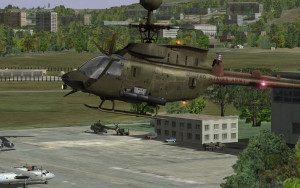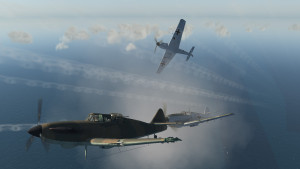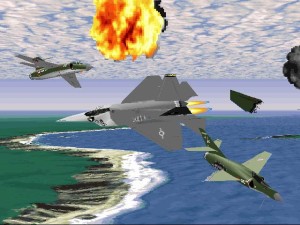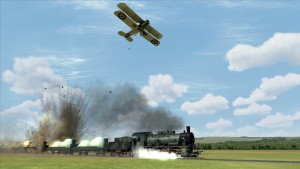Learning to Fly… Among Other Things
Posted by Rampant Coyote on June 9, 2015
Today, I want to talk about hardcore flight simulators. And Rocksmith 2014. Very different games, but I think the former could learn a little from the latter. And for today’s song, Rocksmith 2014‘s entry for Tom Petty’s “Learning to Fly”
I love how Ellison pulls out the slide during that solo. That’s definitely not required by Rocksmith, but it works with or without. So aside from this song, what could this possibly have to do with flying?
Flying the Hard-Core Skies
 I used to fly the virtual skies a lot. My flight simming days probably culminated in a few titles that came out about sixteen years ago: Falcon 4.0, ATF Gold, and Longbow II. Yeah, I was always about the combat flight sims. I actually enjoy the civilian flight sims too – planning a flight, going by instruments or just enjoying the scenery in a really good simulator. But for me, the ultimate fun was yanking and banking in an airborne weapon. Maybe I was too influenced by the movie Top Gun, I dunno…
I used to fly the virtual skies a lot. My flight simming days probably culminated in a few titles that came out about sixteen years ago: Falcon 4.0, ATF Gold, and Longbow II. Yeah, I was always about the combat flight sims. I actually enjoy the civilian flight sims too – planning a flight, going by instruments or just enjoying the scenery in a really good simulator. But for me, the ultimate fun was yanking and banking in an airborne weapon. Maybe I was too influenced by the movie Top Gun, I dunno…
I preferred realism. The more realistic, the better. I wanted to believe that – except for the obvious physical issues (cockpit space, G-forces, monitor limitations, etc), I wasn’t “cheating” – I wasn’t doing anything a real pilot couldn’t do, and I was going through exactly the same process. I wanted to live out that particular fantasy, I guess. I studied books on the subject. And around that time frame, the games were starting to get pretty dang realistic – not only with graphics, but with their ability to simulate aircraft systems with reasonable fidelity. Not only that, but playing online with or against other players became not only possible, but relatively easy.
 The trick was – and is – this: It takes a long time to train a real fighter pilot. In an extremely realistic simulator, you could be expected to spend a similar amount in virtual “training.” You can’t just “kick the tires and light the fires.” Sure, the basics stay the same: Once you know where the throttle, pitch, roll, and yaw controls are (plus cyclic and collective on a helicopter), you can easily get a “feel” for any aircraft and tool around the sky enjoying the sights. Figure out the controls for the flaps, landing gear, taxi steering, and a way to look around the nose of the aircraft (and get a decent idea of the stall speed), and it’s not rocket science to get a plane on the ground in good visual conditions.
The trick was – and is – this: It takes a long time to train a real fighter pilot. In an extremely realistic simulator, you could be expected to spend a similar amount in virtual “training.” You can’t just “kick the tires and light the fires.” Sure, the basics stay the same: Once you know where the throttle, pitch, roll, and yaw controls are (plus cyclic and collective on a helicopter), you can easily get a “feel” for any aircraft and tool around the sky enjoying the sights. Figure out the controls for the flaps, landing gear, taxi steering, and a way to look around the nose of the aircraft (and get a decent idea of the stall speed), and it’s not rocket science to get a plane on the ground in good visual conditions.
 It’s everything else that kills ya. Especially in a competitive environment. If you don’t really have your stuff down, you will be convinced the more experienced players are cheating. How can they fly so much faster, turn so much tighter, or keep evading your missiles? Or if you do something like trying to take down a bomber in a World War II simulation, and discover just why they positioned the guns where they did. You really need to know your own aircraft as well as your target in order to exploit its weaknesses without getting turned into scrap yourself.
It’s everything else that kills ya. Especially in a competitive environment. If you don’t really have your stuff down, you will be convinced the more experienced players are cheating. How can they fly so much faster, turn so much tighter, or keep evading your missiles? Or if you do something like trying to take down a bomber in a World War II simulation, and discover just why they positioned the guns where they did. You really need to know your own aircraft as well as your target in order to exploit its weaknesses without getting turned into scrap yourself.
Dialing it Down a Notch
Back in the day, even those of us who adored the complexity of Falcon 4.0 had a lot of fun playing ATF Gold. It was still a simulator in every sense – allowing you to fly dozens of modern(ish) military aircraft from several armed forces around the world – but the controls were far more simplified. Or, I guess you could say, automated. Whereas in Falcon 4.0 you had to go through a tricky manual process to get a lock on a ground target for your Maverick missiles, in ATF Gold it was as simple as hitting the “Next Ground Target” button, and deciding if that was the target you wanted or not. However, the practical effect was that while a pilot in Falcon 4.0 (or in real life, I have heard…) might need to be lucky and skilled to get two Maverick shots off in a single pass, a pilot in ATF Gold could launch all six of his Mavericks in a single pass, and it wasn’t even interesting. However, within those generous parameters, it was still a simulator.
While flight-sim vets had no problem getting used to it, it could still be daunting to beginners. But the weapons and vehicles all more-or-less behaved according to their real-life parameters. We had some really tremendous online battles in this game. It was realistic enough, I guess. At least someone didn’t have to clock over 100 hours of cockpit time in a single aircraft to have a hope of having fun.
 ATF Gold is the kind of flight sim I don’t seem to see these days – the “mid-level” simulator. it seems that you’ve either ultra-hardcore-realistic (even to the point of blowing away the standard of what we thought was ultra-realistic back in the 1990s), or totally arcade-style with only some semblance of simulation.
ATF Gold is the kind of flight sim I don’t seem to see these days – the “mid-level” simulator. it seems that you’ve either ultra-hardcore-realistic (even to the point of blowing away the standard of what we thought was ultra-realistic back in the 1990s), or totally arcade-style with only some semblance of simulation.
Now, in theory, you’ve got a whole bunch of tools to “dial down” these ultra-realistic simulators with cheats to make them a lot simpler to fly, including an arcade-style flight model, simplified avionics and radar systems, unlimited ammunition (always my favorite), and other tools. These are great if the player even understands what they are and what they do. Even the simplified avionics might require some detailed explanations.
We Need More Than Simplicity
So here’s where I draw the parallels: Flying a realistic aircraft is a challenge in a simulation, particularly with modern instruments. Even flying a World War I era aircraft in a competitive or combat environment (like the excellent Rise of Flight) isn’t easy, but it’s quite within the realm of anybody’s capability, given some training and practice.
And that’s where I’m getting to the parallels. We don’t have the “mid-tier” flight sims anymore, so anybody who might have fun playing Jane’s Advanced Strike Fighters or Ace Combat: Assault Horizon and would like to try something more realistic doesn’t have a clear path. The next step up has a really steep, frustrating learning curve. It’s… like the difference between playing a plastic Guitar Hero controller and a real guitar.
The thing is, learning new skills and exhibiting mastery over skills are inherently fun. We just do a very good job of sucking the fun out of things in our schools. But learning by doing – particularly by playing – is hardwired in our brains’ operating system as fun. A lot of simpler games understand this, and their approach is pretty straightforward. Level 1: You learn and practice a new skill. Level 2: You learn and practice a different skill, built on top of the skill you learned in Level 1. Level 3: You test both of those skills with a twist, like against a boss. Level 4: Learn and practice a new skill. Repeat.
Rocksmith pulled this off to train people to play a real guitar. They made the learning process fun (and in the 2014 edition, made the learning process far more effective. No, it’s not perfect, nor is it (or anything) enough to motivate someone who doesn’t have a serious desire to be able to play competently. But it does a lot to help people get through the grind of the intermediate skill levels and have fun while doing it.
Why can’t these hard core flight sims do the same?
Okay, yeah. “Budget.” I totally get that. It is a tall order – especially since these flight sims aren’t quite the money-makers they once were, and the hardcore ultra-realism is freaking expensive to develop. But these games need to do a better job of making the learning curve more fun to climb. Like Ed GrNot just dry lessons, but giving the player games to play while they learn. Flying through imaginary rings in the sky, scoring strafing runs on stationary ground targets, little “turkey shoots” against airborne drones (or just more stationary targets), speed runs, stuff like that. Combine that with instruction and make an entire training path something that is fun to play for the dozens of hours necessary to get competent with the systems.
 In addition, these simulators should start with the simplified “cheats” turned on by default, and more… the game should automate certain activities as an invisible co-pilot until the player is ready to manually take on that workload. Let the AI handle the electronic countermeasures and dropping the chaff and flares for a while, until the player disables that option. Maybe the AI could assist in handling the flaps, slats, landing gear, trim, and fuel mixture for a while (informing the player of what it is doing the whole time) so the player can focus on the critical mastery of the stick, rudder, and throttle. Oh, yeah, and the guns. Gotta use the guns!
In addition, these simulators should start with the simplified “cheats” turned on by default, and more… the game should automate certain activities as an invisible co-pilot until the player is ready to manually take on that workload. Let the AI handle the electronic countermeasures and dropping the chaff and flares for a while, until the player disables that option. Maybe the AI could assist in handling the flaps, slats, landing gear, trim, and fuel mixture for a while (informing the player of what it is doing the whole time) so the player can focus on the critical mastery of the stick, rudder, and throttle. Oh, yeah, and the guns. Gotta use the guns!
In a properly (but optionally) structured approach, the whole process can be a lot of fun, and the player can be taken from an experience not a whole lot different from playing these “arcade simulators” all the way up to the full complexity of a modern combat aircraft in DCS World. That’s how to develop a new audience.
Not Just Flight Simulators
Now, everything I just said about these hardcore flight simulators apply to every single game genre out there, particularly those that tend towards being complex and harder to get into, like strategy games and role-playing games.
 “Beginner” shouldn’t just be easier opponents.
“Beginner” shouldn’t just be easier opponents.
And we shouldn’t be stuck with dry tutorials. In fact, going through a “tutorial” level in an RPG is one of my least favorite activities, mainly because it is so rarely done right. A tutorial shouldn’t feel like a tutorial… it shouldn’t feel like something you have to “get through” to get to the fun part. While it may necessarily be staged to teach you skills, it should be fun all the way until the training wheels come off. Like the impatient Ed Gruberman wanting to trash bozos with Ti Kwan Leep right now, we don’t want to go through boring training for weeks before we get to the “fun part.” And we shouldn’t have to choose between “fun” and “depth.”
But if you take the theory of fun that “fun” is our brain’s reaction to learning and mastering new skills, then this is something that could be and should be supported throughout. These games should always be introducing new skills, new activities, new things to do. And many of them do (kinda), at least on the first play-through. For strategy games, this can come as part of a tech tree (a reason why it’s so common in popular strategy games…). For RPGs, this comes as the inclusion of new character abilities.
Perhaps they can do a better job of helping the player learn to use these skills. In many casual games, there are fewer options and the level design is structured around this process. But a “smart” virtual coach in these other games could certainly make suggestions and help out.
Yeah, as a game developer, I think, “Ugh, one more thing that’s gonna be costly and painful to add.” And yeah, maybe. But maybe it simply comes down to a better way to handle tutorials, something more player-driven and doesn’t try to teach the player everything up-front in training and expect them to remember it after they’ve not had a chance to play for a month.
If nothing else, if game designers start thinking of these things in terms of staged learning, of helping the player have fun from the moment they click “New Game” from the menu all the way through dozens of hours of gameplay, it’ll be better for the games and for gaming. We shouldn’t have to wait to have fun.
Filed Under: Design, Flight Sims - Comments: 2 Comments to Read

McTeddy said,
This is pretty much the reason I haven’t actually gotten into realistic flight sims despite wanting to. There isn’t really a build-up where I can learn a little bit at a time.
There are dozens of realism switches, but it’s not useful unless I know what they actually mean.
I actually love the idea of the “Co-pilot” who automates tasks, while letting you know he did. This could make learning the tasks far easier to hear the timing and situations where you’ll need to think about things.
Rampant Coyote said,
One of the things Falcon 4.0 did really well is they had a series of training missions – a BIG series of training missions – built into the game. IIRC, they had scoring – but the scoring wasn’t tied too tightly into the actual objectives of the lesson. But at least you had that feeling of progress as you went through the missions.
Flaming Cliffs 3, sadly, only has videos of lessons from a previous version of the game.
I went through one of the training missions for the Huey in DCS, and holy crap… climbing a wall of exposition and lecture, with the ability to click some buttons but not to really be sure if you moved them to the right position or not.
There are fan-made training missions on the web, fortunately, so at least there’s that. It’s something.